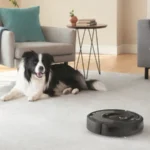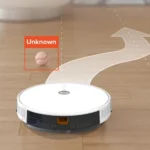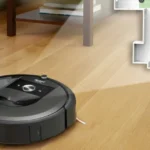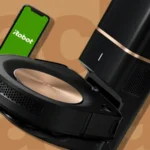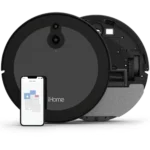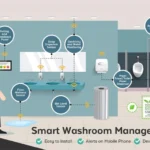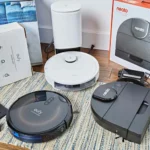Are you tired of spending your weekends cleaning your house? Are you looking for a way to maintain a clean home without sacrificing your leisure time? If so, you might want to consider investing in a smart vacuum cleaner.
Smart vacuums have revolutionized the way we clean our homes, thanks to their advanced sensor technology. These devices are equipped with various sensors that enable them to navigate and clean your home autonomously.
But how do these sensors work, and what benefits do they offer? In this article, we’ll dive into the world of smart vacuum sensors and explore the different types of sensors, how they function, and the benefits they provide. Whether you’re a tech-savvy homeowner or simply looking to make your life easier, this article is for you. So, grab a cup of coffee, sit back, and let’s learn about smart vacuum sensors together.
The Types of Sensors in Smart Vacuum Cleaners
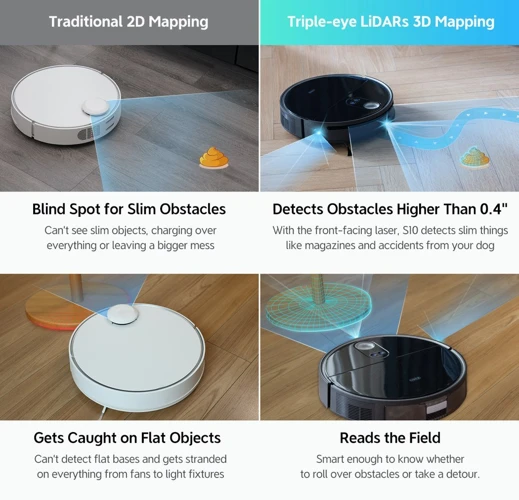
Smart vacuum cleaners are becoming increasingly popular in many households worldwide. One of the main reasons for their popularity is their ability to clean floors efficiently without user intervention. Central to achieving this level of autonomous cleaning is the sensor technology they employ.
1. Optical Sensors: Optical sensors are one of the most commonly used sensors in smart vacuum cleaners. They work by sending out a beam of light and measuring the reflection of this light. This information is then used to identify obstacles and map out the cleaning path.
2. Infrared Sensors: Infrared sensors work by emitting infrared radiation and measuring the reflection of this radiation off objects in the vacuum’s environment. This is used to detect distance and avoid obstacles during cleaning.
3. Ultrasonic Sensors: Unlike the other sensors types, the ultrasonic sensors emit high-frequency sound waves and use the echoes to detect objects around the vacuum cleaner. This sensor technology is especially useful when cleaning in low-light conditions or on uneven surfaces.
4. Bump Sensors: Bump sensors, also known as physical or contact sensors, work by detecting physical contact with an object or obstacle. Once detected, the smart vacuum cleaner will change its current cleaning path and navigate around or over the obstacle.
Each of these types of sensors serves an essential role in enabling effective cleaning by the smart vacuum cleaner. This is because the sensors perform different functions such as navigation, obstacle detection, and obstacle avoidance. By combining these different sensor technologies, smart vacuums can quickly and efficiently clean floors of all types.
To learn more about the functionality of smart vacuum sensors, read about smart vacuum navigation and smart vacuum obstacle detection.
In the next section, we will explore how the sensors work together to enable the cleaning process.
1. Optical Sensors
Optical sensors are one of the most commonly used types of sensors in smart vacuum cleaners. These sensors utilize light to detect the presence of objects and determine the distance between the vacuum and these objects. Optical sensors can be found in various types of smart vacuum cleaners , either as a standalone technology or in combination with other types of sensors. Optical sensors play a key role in helping the robot vacuum navigate around your home and avoid obstacles with precision. As we dive deeper into the world of smart vacuum sensors, it’s essential to understand the different types and functions of each sensor.
2. Infrared Sensors
Infrared Sensors: Infrared sensors are another type of sensor commonly found in smart vacuum cleaners. These sensors use infrared light to detect obstacles and map out a room. They work by emitting a beam of infrared light and measuring the amount of light that reflects back. By using this information, a smart vacuum cleaner can create a map of the room and navigate around objects.
Infrared sensors are particularly useful in low-light situations where optical sensors may struggle to function. For example, if a room is poorly lit or has a lot of shadows, infrared sensors can help the smart vacuum cleaner navigate without getting stuck or missing spots. They are also effective at detecting objects with irregular shapes or surfaces.
The chart below summarizes the main characteristics of infrared sensors in smart vacuum cleaners:
| Pros | Cons |
|---|---|
| -Can function in low-light and shadowy environments | -May be less accurate than other types of sensors |
| -Effective at detecting irregularly shaped objects | -May have difficulty detecting clear or transparent surfaces |
| -Can create accurate room maps | -Sense range is limited to a few feet |
Infrared sensors are a valuable addition to the range of sensors used in smart vacuum cleaners. They provide the vacuum cleaner with additional information about the environment which can help improve its navigation and cleaning performance. However, they may not be as accurate as other types of sensors, and their range is limited to just a few feet.
As smart vacuum cleaner technology continues to develop, we may see improvements in infrared sensor technology as well. This could lead to even more accurate room mapping and navigation capabilities. To learn more about the future of smart vacuum technology and AI, check out our detailed article on The Role of AI in Smart Vacuums.
3. Ultrasonic Sensors
Ultrasonic sensors use high-frequency sound waves to detect obstacles and measure distances in smart vacuum cleaners. These sensors emit sound waves that bounce off objects in the vacuum’s path and then calculate the distance based on the time it takes for the sound to reflect back to the sensor. Ultrasonic sensors work well in detecting objects made of almost any material, and they are not affected by light or colour.
Ultrasonic sensors are highly accurate, making them ideal for smart vacuum cleaners that need to navigate around objects in tight spaces. They can detect objects as small as a toy, a sock or a shoe, helping the vacuum cleaner to avoid collisions and navigate through challenging spaces. In addition to obstacle detection, ultrasonic sensors can also aid in room mapping by measuring distances and creating 3D maps of the surrounding environment.
Here is an overview of the pros and cons of using ultrasonic sensors in smart vacuum cleaners:
| Pros | Cons |
|---|---|
| Highly accurate in detecting small objects | Higher power consumption compared to other sensors |
| Effective in tight spaces | May produce false readings in the presence of certain materials or sound-absorbing surfaces |
| Can aid in room mapping | Can be expensive compared to other sensors |
Some smart vacuum cleaners like Roomba i7+ and Samsung POWERbot R9250 use a combination of ultrasonic sensors and other sensors to navigate and clean effectively. While ultrasonic sensors have their disadvantages, they are still an important component in smart vacuum cleaners and provide valuable assistance in obstacle detection, navigating in tight spaces, and creating 3D maps of the surrounding environment.
4. Bump Sensors
Smart vacuum cleaners are equipped with various types of sensors that enable them to navigate and clean efficiently. One of these sensors is bump sensors. Bump sensors are tactile sensors that are often located on the front of the vacuum cleaner.
These sensors are designed to detect when the vacuum cleaner comes into contact with an obstacle. When the vacuum cleaner bumps into an obstacle, the sensors trigger a change in direction to help the vacuum cleaner avoid the obstacle and continue cleaning in a different path.
Bump sensors are often used in combination with other sensors to ensure that the vacuum cleaner navigates smoothly around the room without missing any debris or bumping into any walls or furniture.
Here is a table summarizing the key features and benefits of bump sensors in smart vacuum cleaners:
| Feature | Benefit |
|---|---|
| Detects obstacles | Helps vacuum cleaner avoid collisions and damage |
| Triggers change in direction | Enables vacuum cleaner to continue cleaning in a different path |
| Used in combination with other sensors | Provides more accurate navigation and cleaning |
Bump sensors are just one of the many sensors used in smart vacuum cleaners to help them navigate and clean efficiently. Many modern smart vacuums use a combination of sensors and cleaning modes to provide a thorough and efficient cleaning experience for users.
How Smart Vacuum Sensors Work
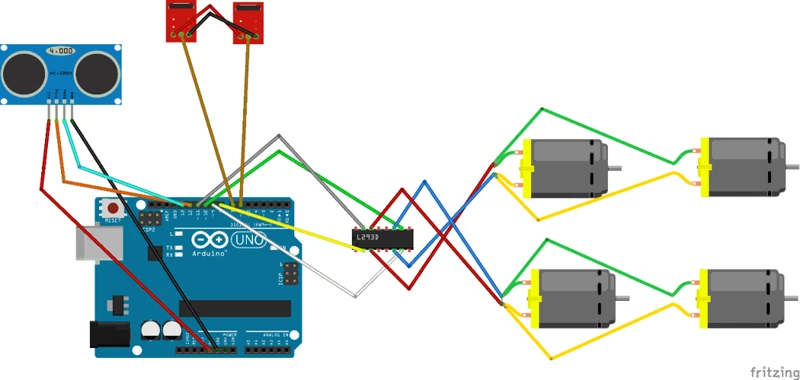
Smart vacuums use a variety of sensors to navigate and clean efficiently. Each sensor serves a specific purpose in the cleaning process.
1. Navigation: Navigation sensors help smart vacuums move around your home without bumping into furniture or other obstacles. Optical and infrared sensors are often used for this purpose. These sensors allow the vacuum to detect the shape and location of objects in a room, helping it create a map of the space.
2. Obstacle Detection and Avoidance: Obstacle detection and avoidance sensors help smart vacuums maneuver around obstacles without getting stuck. Ultrasonic and infrared sensors are commonly used for this purpose. These sensors detect obstacles in the vacuum’s path and help it adjust its trajectory to avoid collisions.
3. Mapping and Localization: Mapping and localization sensors help smart vacuums remember where they have been and where they need to go in a room. These sensors create a map of the space and help the vacuum navigate efficiently. LIDAR (Light Detection and Ranging) sensors are commonly used for this purpose.
4. Battery and Charging Management: Battery and charging management sensors help smart vacuums stay charged and ready to use. These sensors detect when the vacuum’s battery is running low and help it return to its docking station for a recharge.
These sensors work together to create a seamless cleaning experience for the user. By combining the power of mapping, obstacle detection, and battery management, smart vacuums are able to clean floors more efficiently and with less hassle for the user.
1. Navigation
One of the key functions of sensors in smart vacuum cleaners is navigation. How does a vacuum cleaner know where it has been and where it needs to go next? The answer lies in the various sensors that work together to create a map of the cleaning area. From obstacle detection to floor mapping, these sensors play a crucial role in ensuring that your floors are thoroughly cleaned with minimal effort on your part. Let’s take a deeper dive into how navigation works in smart vacuum cleaners.
2. Obstacle Detection and Avoidance
One of the most important functions that smart vacuum sensors perform is obstacle detection and avoidance. This is essential to prevent the vacuum cleaner from getting stuck or damaging itself or your furniture. There are various types of sensors that work in conjunction to ensure that the vacuum cleaner can navigate around obstacles.
- Bump sensors: these sensors detect when the vacuum cleaner bumps into an object. They essentially work like a bumper on a car, allowing the vacuum cleaner to change direction when it hits an obstacle.
- Infrared sensors: these sensors detect the distance between the vacuum cleaner and objects in its path by emitting and receiving infrared waves. They can detect objects in darker areas, which is useful for cleaning under furniture.
- Cliff sensors: these sensors use infrared beams or cameras to detect edges like stairs, preventing the vacuum cleaner from falling off them.
- Ultrasonic sensors: these sensors emit high-frequency sound waves and listen for their reflections to detect objects. They are useful for detecting objects that are above the ground.
- Laser sensors: these sensors use laser beams to create a 360-degree map of the room and detect obstacles. They are generally found in higher-end models.
Once an obstacle is detected, the vacuum cleaner uses algorithms to determine the best course of action to avoid the obstacle while still cleaning the entire room. This may involve backing up and going around the obstacle, or using side brushes to clean around it. Some high-end models can even move furniture out of the way to clean underneath it.
Obstacle detection and avoidance is a crucial function performed by smart vacuum sensors. It ensures that your furniture and the vacuum cleaner itself remain undamaged, and that the cleaning process is as efficient as possible.
3. Mapping and Localization
Smart vacuum cleaners use advanced mapping and localization features to navigate through the environment and clean with precision. Here are the key elements of this technology:
- LIDAR technology: Smart vacuums use LIDAR (Light Detection and Ranging) to calculate distances and create maps of the surroundings. This technology uses beams of light to detect objects and measure their distance. LIDAR provides real-time mapping of a room and helps the vacuum cleaner to clean in a systematic pattern without missing any spots.
- Simultaneous localization and mapping (SLAM): Smart vacuums use SLAM algorithms to create accurate maps of the environment and determine their position within it. SLAM allows the vacuum to navigate through the environment smoothly and avoid obstacles. Every time the vacuum cleaner moves, it updates its map and refines its path for future cleaning cycles.
- Virtual walls: Smart vacuums often come with virtual walls or boundary strips that help keep the device within a particular area. These features are customizable, so you can adjust them to restrict the vacuum from entering certain places, such as rooms with fragile items or pet feeding areas.
- Multi-room cleaning: Some smart vacuums can map out the entire house and clean multiple rooms in one session. This feature is especially useful for larger homes and saves time and effort from manually moving the vacuum from one room to another. With multi-room cleaning, the device can automatically move from one room to another without any manual intervention.
Mapping and localization features allow smart vacuums to clean more thoroughly and efficiently. By creating detailed maps of the environment and using advanced algorithms, they can avoid obstacles, move systematically, and clean hard-to-reach areas. This technology also saves time and effort, especially for people with larger homes, and ensures that every area of the floor is cleaned.
4. Battery and Charging Management
One of the most important features of smart vacuum cleaners is their efficient battery and charging management system. This system ensures that the vacuum cleaner has enough power to complete its cleaning task and will automatically return to its docking station when the battery is low.
Smart vacuum cleaners use different battery types, such as nickel-metal hydride (NiMH) and lithium-ion (Li-ion). Li-ion batteries are widely preferred due to their longer lifespan and quick charging capabilities. They also offer a more consistent power output throughout the charging cycle.
To manage the battery life, smart vacuums use various sensors and algorithms that monitor the battery usage and charging progress. They can estimate the time requirement for charging based on the cleaning area, so the vacuum cleaner can be charged accordingly.
Smart vacuums also come with charging dock stations, which are equipped with sensors to determine the vacuum’s location and docking status. The docking station initiates the charging process automatically as soon as the vacuum cleaner returns to its base.
The table below shows the differences between NiMH and Li-ion batteries used in smart vacuum cleaners:
| Battery Type | Advantages | Disadvantages |
|---|---|---|
| NiMH | Cost-effective Environmentally friendly |
Shorter lifespan Takes longer to charge |
| Li-Ion | Shorter charging time Longer lifespan More consistent power output |
Expensive |
Smart vacuum cleaners with effective battery and charging management systems can help you save time and effort when it comes to cleaning your home. They not only offer efficient cleaning, but they also minimize the downtime needed for charging. This is a game-changer when it comes to ensuring that your home remains clean and healthy.
The Benefits of Smart Vacuum Sensors
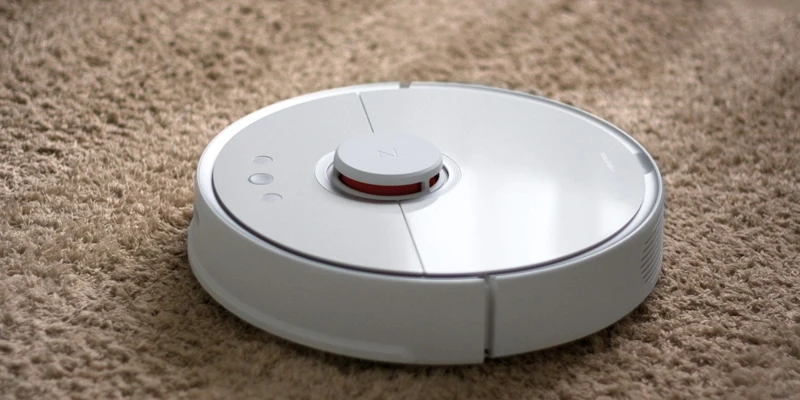
Smart vacuum cleaners equipped with sensors offer several benefits that make them a popular choice among homeowners. Below are a few of the advantages of using smart vacuum sensors for cleaning your home.
1. Time-Saving: One of the biggest benefits of using a smart vacuum cleaner is that it saves a significant amount of time. With sensors like navigation, mapping and obstacle detection, these devices can easily navigate around furniture, avoid obstacles, and map out your home’s layout. This means that you no longer have to spend hours moving furniture around or cleaning hard-to-reach areas. You can simply set up the vacuum cleaner, press the start button and leave the device to get to work.
2. Better Cleaning Performance: Smart vacuum cleaners with sensors offer improved cleaning performance compared to traditional vacuum cleaners. The sensors can detect dirt, dust and debris in hard-to-see areas, and the device can adjust its suction power and cleaning pattern to provide the best cleaning results. Additionally, some smart vacuum cleaners come with advanced features such as dual brushes, HEPA filters and UV lamps, which ensure that all dirt and debris are effectively removed from your floors.
3. Less Maintenance Required: Smart vacuum cleaners with sensors require less maintenance than traditional vacuum cleaners. The sensors can detect when the vacuum cleaner’s dustbin is full, and the device will automatically stop cleaning and alert you to empty the bin. Additionally, some smart vacuum cleaners come with self-cleaning brush rolls that prevent hair and debris from getting tangled in the brush.
4. Increased Safety: Smart vacuum cleaners equipped with sensors improve safety in your home. With features such as bump sensors, the vacuum cleaner can detect obstacles and avoid collisions with walls and furniture. Additionally, these devices can detect drops such as stairs, and automatically move away from the danger zone, increasing safety for individuals living in the home.
Smart vacuum cleaners with sensors offer several benefits that make them a great investment for homeowners. Not only do they save time and effort, but they also provide improved cleaning performance, require less maintenance and increase safety in the home.
1. Time-Saving
We all lead busy lives, and any gadget that can help us save time is a welcome addition to our homes. Smart vacuum cleaners equipped with advanced sensors allow us to delegate the task of cleaning to a machine and free up our valuable time. With their ability to navigate through complex spaces, detect and avoid obstacles, and recharge automatically, smart vacuums make the process of cleaning an effortless and convenient one. Let’s dive deeper into the time-saving benefits of smart vacuum sensors.
2. Better Cleaning Performance
Smart vacuum cleaners equipped with advanced sensors are designed to enhance the cleaning performance in various ways. Here are some of the ways in which sensors significantly contribute to better cleaning performance:
- Efficient Cleaning: Smart vacuum cleaners use a combination of sensors to detect and remove dirt and debris quickly and efficiently. The sensors allow the vacuum to detect the dirtier areas of the floor and focus on cleaning those spots first, rather than wasting time cleaning areas that don’t require as much cleaning.
- Customizable Cleaning: Modern smart vacuums are equipped with sensors that are capable of detecting different types of surfaces. Depending on the flooring type, carpets, hardwood, or tile, the vacuum will adjust its suction power and brush accordingly for optimal cleaning.
- Effective Edge Cleaning: Traditional vacuum cleaners struggle to clean the edges and corners of rooms, but smart vacuums equipped with sensors do not have this issue. The sensors enable the vacuum to detect edges and corners, and adjust its brushes and suction to clean along the edges and corners more effectively.
- Deep Cleaning: Some smart vacuum cleaners come equipped with advanced sensors that not only detect dirt and debris but also detect embedded dirt, dust and allergens. This ensures a more thorough and deep cleaning that is ideal for households with pets and allergies.
- Automatic Adjustment to Floor Level: Smart vacuum cleaners equipped with sensors can detect changes in floor height, which enable the device to transition effortlessly from room to room, up and down carpets and even onto high pile rugs.
The powerful combination of sensors used in smart vacuum cleaners enhances the cleaning capabilities of the device, resulting in better cleaning performance and ultimately, cleaner floors.
3. Less Maintenance Required
Smart vacuum cleaners are equipped with sensors that not only help them navigate, detect obstacles and clean efficiently, but also require less maintenance compared to traditional vacuum cleaners. Here are some reasons why:
No need for manual adjustments: Smart vacuum cleaners use advanced sensors to detect changes in floor types and automatically adjust their cleaning modes accordingly. You don’t have to switch between attachments or adjust the brush roll manually, which saves time and effort.
Effective filter systems: Smart vacuums come with advanced filter systems that not only trap dust and debris effectively but also require less cleaning and replacements. HEPA filters, for instance, can capture dust particles as small as 0.3 microns, which is ideal for people with asthma, allergies or other respiratory issues.
Self-cleaning brushes: Some smart vacuums feature self-cleaning brush rolls that prevent hair and fiber tangles, which can cause the brush to jam or underperform. This means less hair and debris build-up in the vacuum’s brush, reducing the frequency of having to clean it.
Scheduled maintenance alerts: Some smart vacuums come with maintenance alerts that notify you when the filter needs cleaning or replacement, or when something is obstructing the brush roll. This helps you stay on top of maintenance tasks and extends the life of the vacuum cleaner.
Longer battery life: Smart vacuums use advanced sensors to navigate and clean without wasting time and energy. This means they require less battery power to clean the same area compared to traditional vacuum cleaners, resulting in longer battery life and less frequent charging.
Smart vacuum sensors not only enhance the cleaning performance compared to traditional vacuum cleaners but also make maintenance easier and less time-consuming, leading to a better user experience.
4. Increased Safety
Smart vacuum cleaners with advanced sensor technology are not just designed for cleaning convenience, but they also enhance safety in several ways. Here are some of the ways smart vacuum sensors increase safety:
- Preventing Falls: One of the most significant safety benefits of smart vacuums is their ability to prevent falls. These vacuums are equipped with drop sensors that detect gaps or edges, hence preventing the device from falling off stairs, tables, or other high surfaces. These sensors make smart vacuums ideal for homes with young children, seniors, or pets.
- Flame Retardant Materials: Several smart vacuums are manufactured using flame-retardant materials. This means that the device is less likely to ignite, and even if it does, the flame will not spread to other parts of the house quickly. This feature is especially important for households with a gas stove or fireplace.
- Auto Shutdown Feature: Many smart vacuums come with an auto-shutdown feature that shuts down the device if it gets stuck or encounters an obstacle. This prevents the vacuum from overheating or causing other hazards such as electrocution or fire.
- Noise Reduction: Traditional vacuum cleaners are known for producing loud and harsh sounds that can damage our hearing. However, with smart vacuums, this is not the case as they use advanced sensors that help reduce noise levels significantly. This ensures that you can clean your home without causing any disturbance or noise pollution to your neighbors or family members.
Smart vacuum sensors offer a wide range of safety benefits that traditional vacuum cleaners simply cannot match. These unique safety features make smart vacuums an excellent investment for people who prioritize safety in their homes.
The Future of Smart Vacuum Sensors
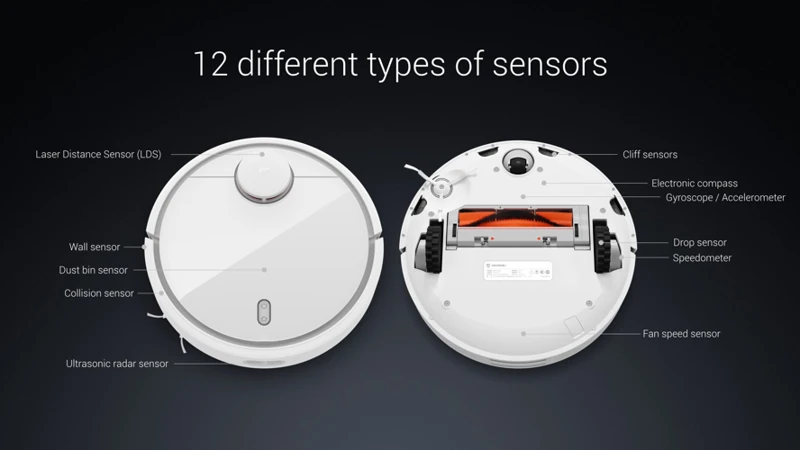
As technology continues to develop at a rapid pace, the future of smart vacuum sensors is becoming increasingly exciting. The integration of these sensors with other smart home products is expected to be a major trend in the coming years.
Integration with Smart Home Systems: The ability of smart vacuum cleaners to integrate with other smart home systems will increase their functionality and ease of use. For example, a homeowner could use their virtual voice assistant to schedule their vacuum cleaner to clean at specific times or in certain areas of the house. This integration will make it easier for people to control their cleaning routines and simplify their daily lives.
Advanced AI and Machine Learning: One area where significant advancements are expected is in the use of artificial intelligence (AI) and machine learning. This technology will enable smart vacuum cleaners to learn and adapt to their environment, making them more effective and efficient cleaners. The ability to learn will allow the vacuum cleaner to gain insights into the homeowner’s preferences and cleaning habits, ultimately providing a more personalized experience.
Multi-Floor Mapping: Another area of development for smart vacuum cleaners is the ability to map and navigate multiple floors in a home. This feature is particularly important for larger homes with multiple levels. With the advancement of sensors and mapping technology, smart vacuum cleaners will be able to effectively clean entire homes without the need for human intervention.
The future of smart vacuum sensors is promising. Advancements in technology will make these devices even more efficient and effective, simplifying the lives of homeowners everywhere. As technology continues to improve, it is certain that smart vacuum cleaners will become an even more integral part of our daily routines.
1. Integration with Smart Home Systems
As technology continues to advance, it’s becoming increasingly common to have a fully integrated smart home system. Smart vacuum cleaners are no exception to this trend, with many models now being designed to seamlessly integrate with other smart home devices such as voice assistants and smart hubs. The possibilities for automation and convenience are seemingly endless when it comes to integrating your smart vacuum cleaner into your home’s wider tech ecosystem. Let’s take a closer look at some of the ways this integration can benefit you and your home.
2. Advanced AI and Machine Learning
The future of smart vacuum sensors includes the integration of advanced AI and machine learning technologies. With these advancements, smart vacuums will be able to learn from their cleaning patterns, adapt to user preferences, and even provide personalized cleaning recommendations.
One example of how AI and machine learning can improve smart vacuum technology is through object recognition. By incorporating computer vision technology, smart vacuums will be able to identify and classify objects in a room, allowing them to clean more efficiently and avoid potential obstacles.
Another benefit of AI and machine learning in smart vacuums is through predictive maintenance. These vacuum cleaners will be able to analyze their own performance and detect potential issues before they become major problems. This will not only increase the lifespan of the vacuum cleaner, but it will also reduce the amount of maintenance required.
Smart vacuums will become smarter at finding their way around your home. With the incorporation of multi-room mapping, these vacuums will be able to navigate more efficiently, remembering the layout of each room and adjusting their cleaning patterns accordingly.
The integration of advanced AI and machine learning technology in smart vacuums will help to improve their cleaning efficiency, reduce maintenance, and provide a more tailored cleaning experience for users. As these technologies continue to advance, we can expect smart vacuum cleaners to become an even more integral part of our daily cleaning routines.
| Benefits of AI and Machine Learning | Examples |
|---|---|
| Object Recognition | Smart vacuums can identify and classify objects in a room to clean more efficiently. |
| Predictive Maintenance | Smart vacuums can analyze their own performance and detect potential issues before they become major problems. |
| Multi-Room Mapping | Smart vacuums can navigate through different rooms more efficiently, remembering the layout of each room and adjusting their cleaning patterns accordingly. |
3. Multi-Floor Mapping
Smart vacuum cleaners equipped with advanced sensors also have the ability to map and clean multiple floors. This is possible due to multi-floor mapping technology, which allows the vacuum cleaner to remember and store the layout of each floor it cleans.
Here are some key features of multi-floor mapping technology that make it so effective:
- Robotic Navigation: Smart vacuums use robotic navigation algorithms to detect and avoid obstacles, map out the layout of the floor, and remember past routes to optimize future cleaning cycles across various floors.
- Intuitive Home Mapping: With the help of multiple sensors, the smart vacuum can scan the entire floor layout and create a digital map of each floor in real-time.
- Memory and Localization: Once the smart vacuum scans the layout of each floor, it stores the map in its memory and labels each floor for easy selection. It can easily recognize which floor to clean, navigate through the floor using the map, and clean the floor efficiently without any human intervention.
- Auto-Resume Cleaning: In case the vacuum cleaner runs out of battery in the middle of cleaning, the multi-floor mapping technology allows it to recharge itself and resume the cleaning process exactly where it left off, without the need for additional guidance.
- Customized Cleaning: Multi-floor mapping technology allows you to customize the cleaning settings for each floor. For example, you can set specific cleaning schedules for each floor or define no-go zones that the vacuum cleaner should avoid during each cleaning cycle.
Multi-floor mapping technology is an incredibly useful feature for those who live in multi-story homes. With this technology, you no longer need to manually carry the vacuum cleaner up and down the stairs or store multiple vacuum cleaners for different floors. Just set the smart vacuum to clean the specific floor and let it do the job for you!
Factors to Consider When Choosing a Smart Vacuum Cleaner
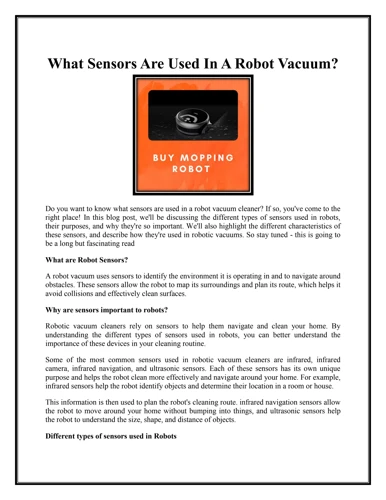
When it comes to choosing a smart vacuum cleaner, there are several factors that you should consider before making a purchase. Here are some of the key factors to keep in mind.
Type of Sensor Technology: One of the most important factors to consider when choosing a smart vacuum cleaner is the type of sensor technology used. Of the four main types of sensors – optical, infrared, ultrasonic, and bump sensors – each has its own strengths and weaknesses. Optical sensors work well in brightly-lit environments, while infrared sensors can detect low-lying obstacles. Ultrasonic sensors are great for detecting objects at a distance, and bump sensors are useful for preventing collisions. Depending on the layout of your home and your cleaning needs, you may want to choose a smart vacuum cleaner that uses a specific type of sensor technology.
Battery Life: Another important factor to consider is the battery life of the smart vacuum cleaner. Typically, smart vacuums can run for anywhere from 60 to 120 minutes on a single charge. However, larger homes or spaces that require more cleaning may require a vacuum with a longer battery life. Additionally, it’s important to consider how long the vacuum takes to recharge once the battery is depleted.
Price: Of course, price is always a consideration when making a purchase. Smart vacuum cleaners vary in price depending on their features and capabilities. While it may be tempting to go for the cheapest option available, it’s important to remember that a higher price point often means better quality and more advanced features.
Brand and Product Reputation: When purchasing any product, it’s important to consider the brand and product reputation. Look for well-known brands that have a proven track record of producing high-quality products. Additionally, read product reviews and customer feedback to get an idea of how the smart vacuum cleaner performs in real-world usage scenarios.
There are several factors to consider when choosing a smart vacuum cleaner. By taking the time to research and compare different options, you can find a vacuum that meets your cleaning needs and provides efficient and effective cleaning performance.
1. Type of Sensor Technology
When it comes to choosing a smart vacuum cleaner, one of the most important factors to consider is the type of sensor technology used. Different sensors can have a significant impact on the vacuum’s cleaning performance, as well as its ability to navigate around obstacles and map out a room. With so many options available on the market, it can be overwhelming to decide which type of sensor is best suited for your cleaning needs. In this section, we will explore the various types of sensor technology used in smart vacuums and provide insights to help you make an informed decision.
2. Battery Life
Smart vacuum cleaners rely on battery power to operate, making battery life an important consideration when choosing a model. The battery life of smart vacuums can vary widely depending on factors such as the size of the battery, the power consumption of the motor, and the type of surfaces being cleaned. It’s important to choose a model that has a battery life that suits your needs and cleaning routine.
Here are some important things to consider when evaluating the battery life of a smart vacuum:
| Factor | Explanation |
|---|---|
| Battery capacity | The higher the battery capacity, the longer the vacuum can operate without needing a recharge. Look for models with high-capacity batteries that are appropriate for the size of your living space. |
| Run time | Not all vacuums with high-capacity batteries have long run times. Some models may use more power or have less efficient motors, resulting in a shorter run time. Look for models with a run time that meets your needs. |
| Charging time | Consider how long the vacuum takes to recharge fully. Some models may take several hours to recharge, which can be inconvenient if you need to use the vacuum frequently. Look for models with fast charging times. |
| Battery life span | Over time, batteries can lose their ability to hold a charge. Look for models with high-quality batteries that are designed to last for years of regular use. |
It’s important to note that battery life isn’t the only factor to consider when choosing a smart vacuum cleaner. You should also consider the type of sensor technology, the cleaning performance, the maintenance requirements, and the overall cost of the vacuum. By evaluating all of these factors together, you can choose a model that meets your needs and fits your budget.
3. Price
When it comes to choosing a smart vacuum cleaner, price is an important factor to consider. While these devices offer a range of features and benefits, they typically come at a higher cost than traditional vacuum cleaners. That being said, it’s important to weigh the cost against the benefits to determine whether a smart vacuum cleaner is right for your needs.
The Average Cost of Smart Vacuum Cleaners
The cost of a smart vacuum cleaner can vary depending on the brand, features, and technology used. Some budget-friendly options start at around $150, while more advanced models can cost upwards of $1,000 or more. Here is a breakdown of general price ranges for different types of smart vacuum cleaners:
| Type of Smart Vacuum Cleaner | Average Price Range |
|---|---|
| Entry-level robot vacuums with basic features | $150 – $300 |
| Mid-range robot vacuums with advanced features | $300 – $600 |
| High-end robot vacuums with advanced features and mapping technology | $600 – $1,000+ |
It’s important to note that while a higher price can indicate more advanced features and better performance, it’s not always the case. Research and read reviews to ensure that you’re getting the best value for your money.
Additional Costs to Consider
In addition to the initial cost of the smart vacuum cleaner, there may be additional costs to factor in. For example, some models require specific filters or cleaning tools that need to be purchased separately. Additionally, some smart vacuum cleaners may require ongoing maintenance or replacement parts over time, which can add to the overall cost.
Is a Smart Vacuum Cleaner Worth the Price?
Ultimately, the decision of whether a smart vacuum cleaner is worth the price depends on your individual needs and budget. If you’re looking for a device that can save you time and effort while providing a more thorough cleaning, a smart vacuum cleaner may be a good investment. However, if you’re on a tight budget and don’t require advanced features such as mapping and navigation, a traditional vacuum cleaner may be a better choice.
When making a purchasing decision, it’s important to consider your specific needs, budget, and the features offered by different smart vacuum cleaners to make an informed decision.
4. Brand and Product Reputation
When it comes to purchasing a smart vacuum cleaner, brand and product reputation are important factors to consider. Here is a list of some reasons why brand and product reputation matter in the world of smart vacuums:
- Reliability: Well-known and reputable brands are more likely to produce reliable products with fewer malfunctions or defects. This can save you time and money on repairs or replacements.
- Customer Support: Choosing a reputable brand can ensure you have access to helpful customer support if you encounter any issues with your smart vacuum. Brands with a good reputation for customer service can provide prompt assistance in resolving any problems, giving you peace of mind knowing that someone has your back if anything goes wrong.
- Quality: Brands that prioritize quality can produce smart vacuums with high-end features and capabilities. These top-of-the-line vacuums can offer better performance and advanced technology for a more effective and efficient cleaning experience, which can ultimately save you time and effort in the long run.
- Longevity: A well-built and well-maintained smart vacuum can last for years, so choosing a reputable brand can help ensure that you invest in a product that will stand the test of time. This will also save you money in the long run, as you won’t have to replace your smart vacuum as frequently.
Before purchasing a smart vacuum cleaner, take some time to research and compare product reviews, manufacturer reputation, and customer satisfaction ratings to make an informed decision that fits your cleaning needs and budget.
FAQs About Smart Vacuum Sensors
Now, let’s address some of the frequently asked questions about smart vacuum sensors that you may have in mind.
1. What is the Best Type of Sensor for a Smart Vacuum?
Different sensor technologies excel in different situations. Optical sensors work well in detecting edges and drop-offs, while infrared and ultrasonic sensors are effective in identifying obstacles and objects. Bump sensors are best suited for handling collisions.
However, the effectiveness of each sensor type depends on the specific environment your smart vacuum will be operating in. It is best to choose a smart vacuum cleaner that incorporates a combination of different sensor types for optimal performance.
2. How Do Smart Vacuums Handle Stairs?
Smart vacuums use sensors to detect edges and drop-offs, enabling them to avoid tumbling down staircases or ledges. Most models are equipped with cliff sensors that detect changes in height and adjust the vacuum’s path accordingly. You can also control your smart vacuum to direct it away from stairs or to manually guide it safely down the staircase.
3. Can Smart Vacuums Clean Multiple Rooms?
Yes, smart vacuums can clean multiple rooms using advanced mapping and localization technologies. Once the vacuum maps out the layout of your home, it can remember the different areas and clean them systematically.
Some models can also be programmed to clean certain rooms at specific times, whereas others allow you to control and monitor the cleaning process from your smartphone app.
As with any household tool, factors like battery life, brand reputation, and overall price will come into play when choosing the best smart vacuum for your home. By understanding the different types of sensors used in smart vacuums and their functionality, you’ll be able to make an informed decision when going for a purchase.
1. What is the Best Type of Sensor for a Smart Vacuum?
With so many different types of sensors used in smart vacuum cleaners, it can be confusing to determine which one is the best. However, it ultimately comes down to the specific needs and preferences of the user. While some sensors may excel in navigation, others may be better at obstacle detection and avoidance. Additionally, newer models may incorporate a combination of different sensors for even better performance. In this section, we will explore the various sensor options available and their respective strengths and weaknesses to help you make an informed decision.
2. How Do Smart Vacuums Handle Stairs?
Smart vacuums utilize a combination of sensors and advanced technology to handle stairs in a safe and effective manner. Here are the different ways in which they handle this task:
- Cliff Sensors: Smart vacuums are equipped with sensors that can detect the edges of stairs and prevent the vacuum from falling off the edge. These sensors emit a signal that bounces back when it encounters an edge or a drop-off, signaling the vacuum to change direction.
- Mapping Technology: Some smart vacuums use mapping technology to locate and avoid stairs before they even approach them. This enables the vacuum to plan a safer route around the stairs in advance.
- Virtual Walls: Smart vacuums often come with virtual walls that can be placed around the perimeter of an area. These walls act as a barrier, preventing the vacuum from approaching the stairs altogether.
In addition to these technologies, smart vacuums also have the ability to save their progress and return to cleaning once they have been moved to a different level of the home. This is thanks to their advanced mapping and localization capabilities that allows them to accurately navigate and remember the layout of your home.
It is important to choose a smart vacuum with reliable stair detection and avoidance technology to prevent any potential accidents or mishaps. Make sure to do thorough research and read reviews to find the best option for your needs.
3. Can Smart Vacuums Clean Multiple Rooms?
One of the most convenient features of smart vacuum cleaners is their ability to clean multiple rooms without requiring any human effort. This is made possible by the sophisticated mapping and navigation systems that are integrated into these devices, which allow them to move around your home seamlessly.
So, can smart vacuums clean multiple rooms? Yes, they can! In fact, many smart vacuum models are specifically designed to clean large homes with multiple rooms.
To understand how these devices are able to accomplish this feat, it’s important to first understand how they navigate and map your home. Typically, smart vacuums use a combination of sensors and cameras to create a detailed map of your living space. This allows them to identify obstacles, avoid collisions, and maneuver around furniture and other objects in their path.
Once the mapping process is complete, you can program your vacuum to clean specific rooms, or allow it to run on its own and clean your entire home. Some models even have the ability to map multiple floors, so you can program your vacuum to clean every room in your home with just a few taps on your smartphone.
When your vacuum is cleaning multiple rooms, it will typically move from one room to the next using the most efficient path possible. This ensures that all areas of your home are cleaned thoroughly, without any wasted time or effort.
Factors to Consider When Choosing a Smart Vacuum Cleaner
If you’re in the market for a smart vacuum cleaner that can clean multiple rooms, there are a few important factors to consider. These include:
| Factor | Considerations |
|---|---|
| Type of Sensor Technology | Look for a model that has reliable sensors and mapping capabilities, such as infrared or laser-based sensors |
| Battery Life | Make sure your smart vacuum has a long enough battery life to clean multiple rooms in one go |
| Price | Smart vacuum cleaners can range in price from budget-friendly to high-end options, so consider your budget when choosing a model |
| Brand and Product Reputation | Do some research to find a brand and product with a good reputation for quality and reliability |
By considering these factors, you can choose a smart vacuum cleaner that will meet your needs and keep your home clean and tidy, even in multiple rooms.
Conclusion
In conclusion, smart vacuums with advanced sensor technology are revolutionizing the way we clean our homes. With optical, infrared, ultrasonic, and bump sensors, these devices are able to navigate our homes efficiently and effectively, avoiding obstacles and mapping out rooms for optimal cleaning performance. As technology advances, we can only expect these devices to become smarter, more intuitive, and more integrated into our homes.
If you’re in the market for a smart vacuum cleaner, there are a few key factors to consider. Think about the type of sensor technology you want, as well as the battery life, price, and brand reputation. You also want to make sure your chosen device has the features you need, such as mapping and localization or multi-floor capabilities.
Overall, the benefits of smart vacuum sensors are clear. They offer time-saving convenience, better cleaning performance, and increased safety by avoiding obstacles and potential hazards. As technology continues to advance, we can expect even more advanced sensor technology in these devices.
So, whether you’re looking to upgrade your cleaning routine or just interested in keeping up with the latest advances in home technology, a smart vacuum cleaner with advanced sensor technology is definitely worth considering. With a range of brands and options available, there’s sure to be a smart vacuum that meets your needs and exceeds your expectations.
Frequently Asked Questions
1. What is the difference between optical and infrared sensors?
Optical sensors use light sensors to detect obstacles, while infrared sensors use infrared light to detect obstacles. However, optical sensors tend to be more accurate in detecting small objects, while infrared sensors are better at detecting larger objects or walls.
2. How do ultrasonic sensors work?
Ultrasonic sensors emit high-frequency sound waves that bounce off of objects and return a signal to the vacuum to determine the distance and location of obstacles.
3. Can smart vacuums be controlled with a smartphone app?
Yes, many smart vacuums can be controlled using a smartphone app, allowing you to schedule cleanings, adjust settings, and monitor the vacuum’s progress from anywhere.
4. Do smart vacuums have different cleaning modes?
Yes, most smart vacuums have multiple cleaning modes, including spot cleaning, edge cleaning, and auto cleaning, which adjusts to the layout and dirt level of the room.
5. How do smart vacuums prevent themselves from falling down stairs?
Most smart vacuums use infrared or acoustic sensors to detect drops and prevent the vacuum from falling down stairs or ledges.
6. Can smart vacuums clean carpets and hardwood floors?
Yes, many smart vacuums can clean both carpets and hardwood floors. Some models have special cleaning modes for carpets that include brush rolls and stronger suction.
7. How often do smart vacuum filters need to be changed?
It depends on the model and usage, but most smart vacuum filters should be replaced every three to six months for optimal performance and air quality.
8. Do smart vacuums require much maintenance?
Smart vacuums require minimal maintenance, typically consisting of emptying the dustbin, cleaning the brush roll and sensors, and replacing the filter periodically.
9. Can smart vacuums be used to clean pet hair?
Yes, many smart vacuums are designed to pick up pet hair, and some even have specialized brushes and modes for pet hair removal.
10. How much should I expect to pay for a smart vacuum?
The price of a smart vacuum varies depending on the brand, features, and technology. On average, a mid-range smart vacuum can cost anywhere between $200-$500, while high-end models can cost over $1000.

